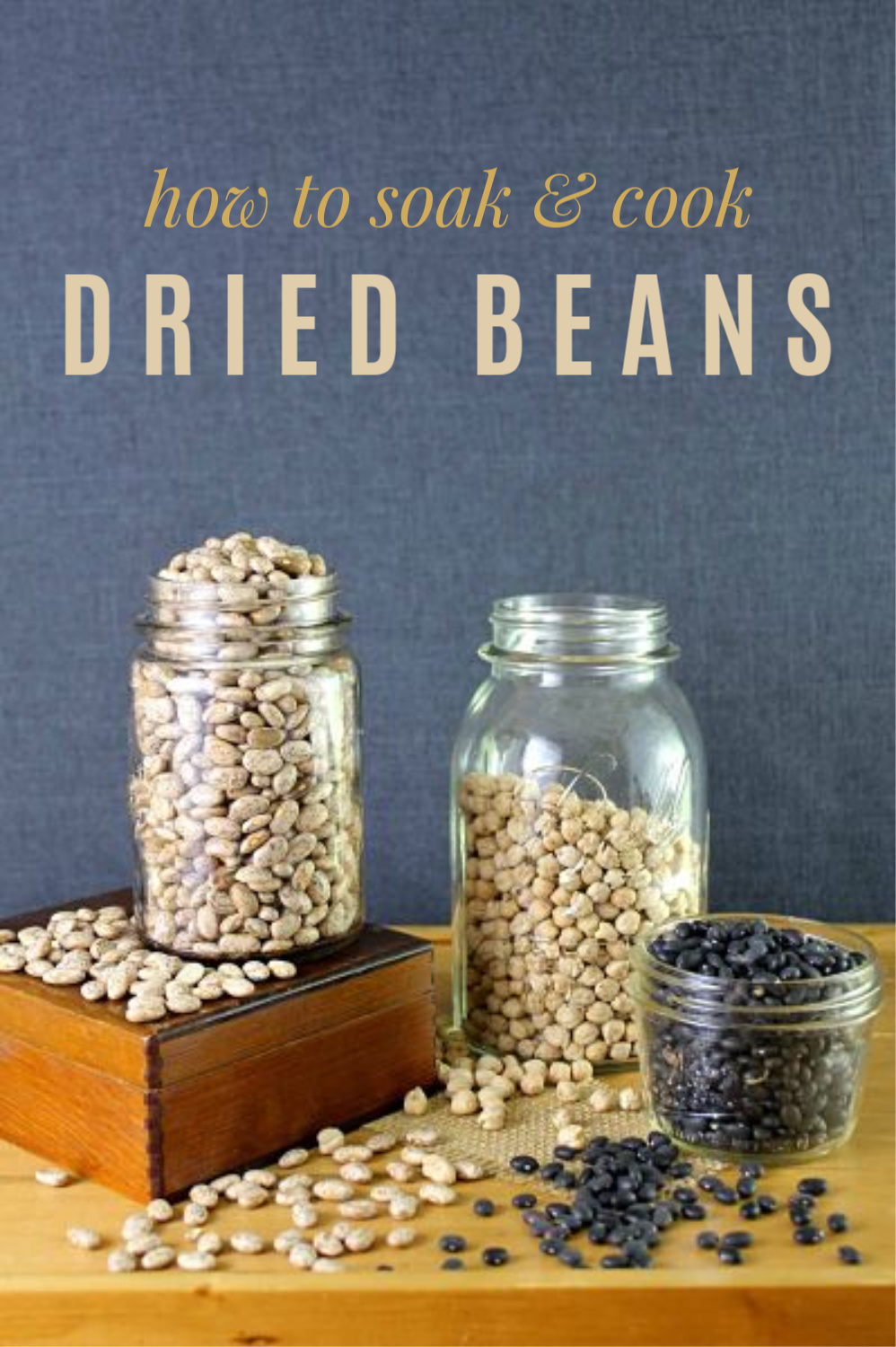
Beans are incredibly versatile and economical. My pantry is stocked with cans of beans I bought, and my freezer is stocked with bags of beans I cooked. If I can find quality canned beans on a good deal, I stock up. If I have the time but not the money, I cook my own.
Once you see how easy it is to cook beans from scratch, it will give you one more way to stretch your grocery bucks as far as they can go. After all, thawing a bag of beans is every bit as easy as cranking open a can. Like I read on one online forum, “Beans in the freezer are like money in the bank.” Now that’s my kind of math. And the added bonus? Not only do you spend less money, but you also control the ingredient list.
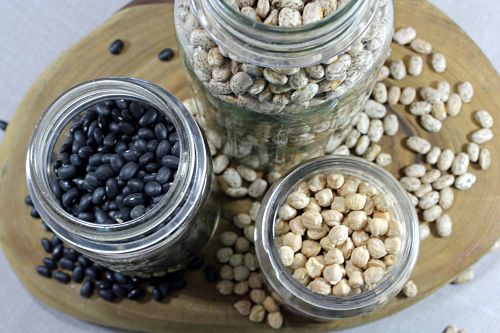
Health Benefits
Beans are high in protein and low in fat. They are a great source of soluble fiber which helps remove harmful cholesterol from your body before it’s absorbed. Incorporating beans into your diet can help lower your cholesterol and reduce your risk for heart disease, heart attacks, and breast & prostate cancer. In fact, studies have found Hispanic women have half the risk of breast cancer as white women. Researchers attribute this, in part, to the high quantity of legumes in their diet. Cool beans.
Ingredients
The ingredient list in most commercially canned beans is actually pretty basic: water, beans, and salt. Most brands also contain calcium chloride which is a firming agent, and many brands include sugar which is just wrong. I’m not interested in debating this topic, but if you’re looking to cut down on BPA consumption in canned products and can’t find an affordable option, cooking dried beans is a great place to start.
Price & Quality
There is a reason Dave Ramsey advocates a “beans and rice” diet when counseling people out of debt. It’s cheap. You can find canned black beans at Winco for as low as 60 cents a can. Dried black beans are even cheaper than this. Winco sells their generic bags for 90 cents a pound.
One pound of dried beans = about six cups of cooked beans. Six cups for around $1!
The bulk section is often an even better deal. Fred Meyer, Winco, and Bob’s Red Mill are all good options, depending on your budget and your taste. If you order through Azure Standard, their selection is very similar to Bob’s, but their prices are cheaper. Look for a store with a high turnover rate to ensure the freshest products and the best results.
Of course, if we’re debating quality, canned beans can’t even begin to compare with the flavor and texture you get from cooking them from scratch. So let’s get started.

This soaking & cooking method will work for any bean that requires a long cooking time such as black-eyed peas, garbanzo beans, cannellini beans, pinto beans, etc. Pretty much anything but lentils.
How to Soak and Cook Dried Beans
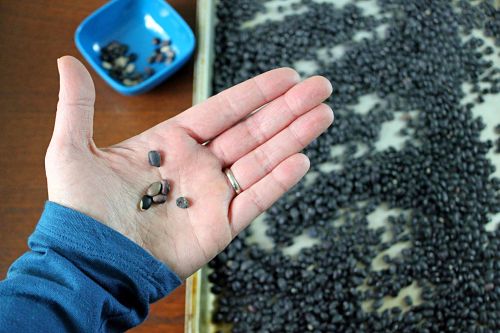
Pour the dried beans onto a rimmed baking sheet. Pick out any cracked or wrinkled beans, as well as any small stones or dirt.
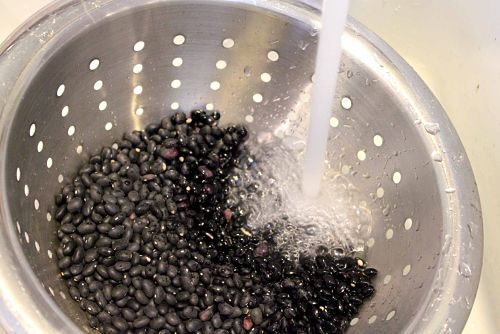
Dump the beans into a colander and rinse with cold water.
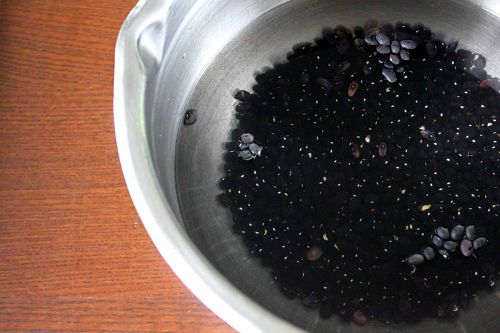
Put the rinsed beans in a large bowl and cover with several inches of cold water. Soak overnight, around 6-8 hours.
There are a couple different reasons for soaking beans before cooking them:
- It helps them cook faster. The larger the bean, the longer the soak. The longer they soak, the faster they cook.
- It leaches out carbohydrates that our bodies cannot digest. When beans move through our lower intestine, bacteria breaks down what our digestive enzymes can’t, resulting in gas. One author called it “digestive difficulties.” My 2-year old calls it something else, but we won’t get into that.
Soaking isn’t absolutely necessary and some people avoid it, saying it also removes vitamins and minerals. Personally, I’m all about cutting down on cooking time and “digestive difficulties.” I’ll get those vitamins and minerals from other sources, thank you very much.
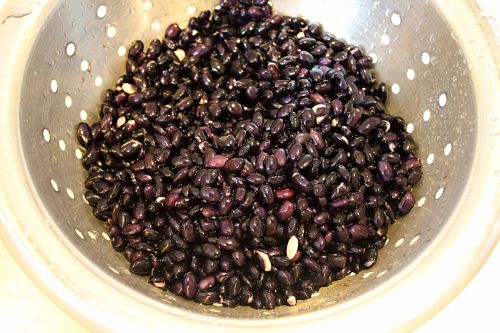
In the morning, pour out the water and rinse the beans. Black beans will be pleasantly plump and purple.
Pour the beans into a wide, heavy pot and cover with about two inches of water. Place over medium-high heat.
If you want to add any herbs, vegetables, or spices to kick up the flavor, this is a good time. Don’t add any salt yet because it will prevent them from absorbing water, slowing down the cooking process. Wait until the end when the beans are tender.
The water will quickly turn black and foam will come to the surface. Scoop off the foam and bring the water to a boil. Reduce the heat, cover the pot, and simmer on low. If you prefer using the oven, you could also bake the beans at 300 degrees. Check them as they cook, adding more water if needed.
Cook until tender, anywhere from 40 minutes to 1.5 hours, depending on the variety.
Black beans usually take around 50 minutes. Although they cook pretty quickly, you are not going for speed here. Your goal is a nice, easy simmer. Sample a few beans before removing them from the heat. You want them to be tender but not mushy.
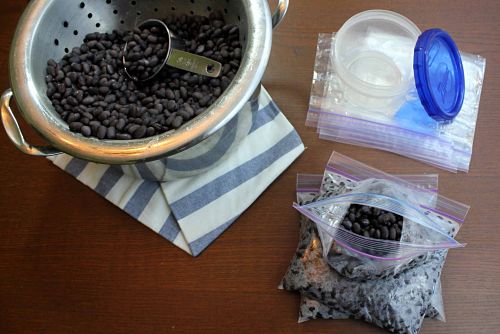
Remove from the heat and sprinkle with salt, if desired.
Let the beans cool in the cooking water, absorbing the salt as they cool. This will give them better texture and flavor. If you want to keep the cooking water, it can be used like a bean broth and added to vegetable soups to boost the flavor.
How to make a basic bean soup.
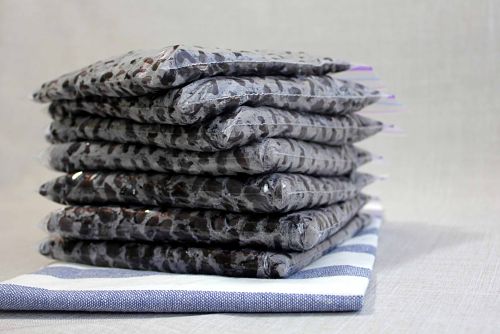
Cool the beans completely, split into small containers or bags, and freeze. Store the cooked beans, covered, in the refrigerator for up to four days or in the freezer for up to six months.
If I am using the beans on a salad or in a wrap, I thaw them under warm water or in the microwave. If I am making chili or soup, I just toss the frozen beans directly in the pot.
So there you have it : sort, soak, rinse, cook, salt, cool, freeze. See? Those bags of dried beans really aren’t as intimidating as they may seem. You can do this! Your wallet and your taste buds will thank you.
**********************************************
Want to read more? Amazon has Bean by Bean: A Cookbook by Crescent Dragonwagon (no joke) in stock and ready to ship!
Looking for more resources?
Looking for more delicious recipes using beans?
Read more in our All About Beans series, including how to make crockpot pinto beans and homemade hummus.
This post may contain affiliate links. See the disclosure policy for more information.

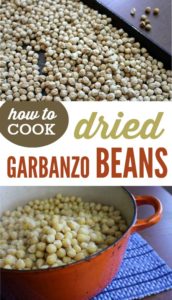
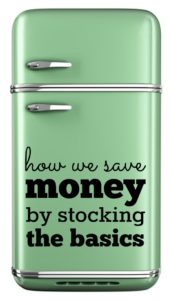


Thanks so much! I look forward to trying this soon! I’ve always wanted to make my own but the only good recipes I’ve gotten from friends involve a lot of lard. We’re trying to eat healthier so that doesn’t really work for us. Definitely a money saver though!
I noticed you say that you don’t mash the beans when they’re done cooking. Do you freeze them in their liquid? Or do not used them as refried beans, just as a good way to cook and flavor them as whole beans? If you do mash them eventually, what do you thin them out with?
Thank you so much for these wonderful instructions! I have recently begun the switch to dried beans and have only a few more cans in the cupboard to go before I will be using 100% dried.
However, I have searched and searched and cannot find the answer to my nutrition question. So perhaps you, the reader of the Bean Bible, can help me?
Here are the facts for the dried, followed by the canned black beans:
Serving Size 1/4 cup dry (equals 1/2 cup cooked)
Calories 70
Total Fat 0.0 g
Saturated Fat 0.0
Cholesterol 0.0 mg
Sodium 20.0 mg
Total Carbohydrate 23.0 g
Dietary Fiber 15.0 g
Sugars 1.0 g
Protein 9.0 g
(Canned Black Beans of the same brand)
Serving Size 1/2 Cup
Calories 90
Total Fat 0.5g
Saturated Fat 0g
Cholesterol 0mg
Sodium 460mg
Total Carbohydrate 19g
Dietary Fiber 6g
Sugars <1g
Protein 7g
Now, my question is, how can the canned beans have more calories, less than half the fiber, and less protein than the dried beans when in the end they're the same thing?? I mean, this definitely gives a strong argument (as if there weren't enough already) for using dried beans, but how can the numbers be so drastically different? Am I really consuming 15g fiber in one serving of dried beans, or does the cooking make them have less? Thanks for your time, I really am baffled by these differences.
My question is could canned beans be as healthy as dry beans if the canned beans are thoroughly drained? On a can of goya black beans the sodium content is 460 mg per serving (holy sodium batman), on a bag of black beans the sodium content is 20 mg (holy difference batman). Do you think the sodium content of the canned beans is reduced significantly if drained of all those delicious juices?
I just made beans yesterday. They were “great northern beans” using your method for cooking.
I used this recipe for baked beans http://www.food.com/recipe/old-time-baked-beans-29785
Although the sauce was awesome, the beans were so dry. Could this have been the bean type? a cooking error in my part, or could the beans have been too old? I cooked the beans the day before I cooked the recipe 🙁
I wonder if they weren’t cooked long enough? I made black beans the other day that were too dry/hard because I pulled them off the heat too soon. I simmered them for about 10 more minutes to hit the desired consistency. I haven’t done great northerns yet; I’ll have to try them and see what happens…
Wow! Thanks for this great info about the BPA in the cans. After doing some digging, we found out that even our favorite organic canned beans have BPA in them! Putting them in a freezer is a great idea, too.
It is so coincidental that you have this posted! I was laying in bed last night, thinking about how I was going to use non-BPA canned beans for cheap b/c I was looking at the Edegn ORganic ones on Amazon and they are almost $3 a can! Yikes. So I was laying in bed wondering if I cooked them and canned them myself, if that would work, but I hadn’t considered freezing them. Thanks for the idea! We use lots of beans too, and now I can use them easily and not worry about the BPA!
awesome.. our huge family loves beans and am so excited to have a new way of making them fit the budget.. thanks… love this sight….
Would the steps/recipe be the same for Great Northern beans?
They are similar to black and pinto so I would say yes.
My husband is from a rural part of Mexico and beans are our life. I’ve not had much success shortening the cooking time by soaking my beans, but sometimes I do it if I sort them at night. We eat all kinds of beans: white, red, black, pinto, limas and black eyes peas. All cook the same way, just alter the cooking time until done cooking. Add a piece of onion and some garlic and the flavor really takes off.
Thanks so much for linking to my article on “How to Cook Dried Beans”.
I’ve so glad to see how interested readers are in how to cook the lowly, yet tasty dried bean!
A Note: black-eyed peas, lentils, peas (whole or split) DO NOT REQUIRE SOAKING.
My article on SALT (http://www.chezbettay.com/pages/health1/h_saltbody1.html) might be of interest to you and make the beans taste even better. Try a variety of natural salts and season individual batches and then try the taste. Let me know what you think!
I absolutely cannot believe that I never knew you could freeze beans!!! We freeze our own corn, pumpkin puree, etc… but I never thought about beans. I always hesitate to make them because I hate having to find a million ways to use them up before they go bad in the fridge, but now I know you can freeze them!
You might just be the bean-savior of my night. : )
I cook a bunch at a time, drain, and spread on a baking sheet lined with wax paper (or washed-and-dried cereal bags). Place the baking sheets (level—experience talking there) in the freezer. Give a slight freeze—half hour or longer–then dump into freezer container (bag, jar, etc). This allows you to take out only what you want without them clumping together.
Well that explains it. Is it possible to get beans that just don’t work? I soaked kidney beans for 24 hours (forgot about them) and they were still fairly firm and hubby and I deffinately had “digestive difficulties” after eating them. They didn’t get any softer after cooking in the crockpot. I would guess salt factored there but why didn’t they soften much after a 24 hour soak. I’d really like to use them again.
This post is really helpful and inspiring. I am motivated to start soaking beans tonight… I did not know that you could freeze them!
I love this post…I didn’t know you could freeze beans! Wowsers, that opens up a whole new world for me. Thanks!
Um, totally appreciate your sense of humor. Thanks for a laugh! 🙂
My parents are both mexican and one thing my mom always gave us was the bean broth because she said that’s where a lot of the vitamins are after cooking. As a matter of fact, babies were fed the broth mixed with gerber rice cereal or corn tortillas cut into tiny pieces. Besides it has all the flavor. Why would you throw it away and freeze them dry? Plus I find the juice helpful when making refried beans or chili beans. Personally, I just freeze them w/ the broth in ziplock containers w/ lids.
So don’t throw your flavorful vitamins away… 🙂
Okay, this does not serve the same purpose as do it yourself beans, but they are delish so I am going to share 🙂 My hubby worked for a beanery in Wyoming and they sold dehydrated refried beans. Here’s a link to something similar (just different brand)
http://www.mexgrocer.com/1419.html
these were the BEST, quick, easy and so so good! Everyone is a skeptic at first, but a believer after one bite. I also worked at a Migrant school and even the parents loved them. Yes, they are that good.
Thanks so much for this post. I have tried to make beans less the can a couple of times now and they have not come out right. I think I have been adding the salt to early, good to know.
Can you use the frozen beans in cold salads? I love bean salad but am not sure the frozen beans would taste as good.
I do and it works fine. 🙂
I’m not sure if this was covered yet, but are the directions the same for kidney beans?
Yes, you would follow the same steps for kidney beans.
Because they are larger, they will take longer to cook. If you are using the stovetop, you will simmer them on low for around 2-2.5 hours.
Hope that helps! 🙂
Just a thought — when I freeze my beans, I always include a small amount of liquid from the pot (just like they come in the can), without it, they can come out of the freezer a little “dried up” tasting or get freezer burn more easily. Also saves a step (straight from the cooled pot to the ziploc bags).
Thank you so much for this! I am loving these posts 🙂
Perfect timing! My husband and I were just talking about canned vs. dried beans last night. We eat beans all the time because they are so cheap and they are good for you!
One of these days I’m aiming to can my own beans since having them ready on the shelf makes me happy. Plus we don’t use a lot of them, but yes, it’s way cheaper (especially now!) to start with dried beans anyway.
somewhere I read a tip that to really avoid digestive problems, rinse the beans several times as well as the pot they soak in each time. let me tell you, it really makes all the beans I have tried this way to be gas free which is important in a household with 3 men/boys!
I love using dried beans and stopped buying canned ones several years ago when I found a recipe to can my own. It is very simple and very convenient. Plus, I know what is in them and I get a lot less salt in my diet. Just one thing to remember when cooking beans–NO SALT DURING THE COOKING. Adding salt to dried beans while they are cooking can cause them to be tough. You will obtain good flavor when you add the salt at the end.
Unless you do them in the crockpot. In that case you get soft & flavorful beans that were cooked with salt. 🙂
If you only cook some beans,I find pinto are the cheapest in the dried form–I never buy them in cans and freeze them regularily. Even blending them after cooking , before freezing for refried beans. I do buy canned beans for convenience but never spend over 40 cents a can. I have frozen all kinds including garbonzo and soy beans( both are harder to find dry) .
Love your writing! You are hilarious and it makes for an awesome read! 🙂
I’ve been cooking beans from scratch since I married my hubby and we moved to Honduras where beans are served three times a day! To save on dishes, soak in the crockpot over night, or soak in the pot you’re going to cook with, then just turn it on in the morning. My hubby was aghast when I rinsed them after soaking b/c he said I took out all the good flavor (now I rinse them when he’s not looking – haha!). When boiling, we add chopped onion, garlic, and of course you can’t go without cumin.
On freezing: sometimes I blend them first, then freeze for future “refried beans” (healthy version). You know what makes homemade refried beans super duper delish?? Blend them with fresh onion first, then heat them on the stove with a little EVOO. The onion makes a huge difference and they turn out so yummy!
All my friends from Mexico do it this way 🙂 I’ve done it both ways and haven’t noticed that much difference.
Hi, yes we love beans! I don’t soak overnite but I do bring to a boil then pull off the heat and let them soak for about an hour then drain. I also put in about a teaspoon of baking soda in the soak water. This seems to take away the ‘digestive difficulties’.
Freezing beans! Wow, it had never occurred to me, but it makes so much sense. Thanks for the post. And by the way, I love reading your blog. You are a hoot! Keep on writing!
Another option on the soaking is to do a fast cook on the beans. If you put them in a pot, bring to a boil for 5 mins, take off the burner then let sit on the stove for an hour it is the same effect as soaking. We have had mixed results with soaking, especially if it is cold out, but have always had good results with this method. We actually freeze after doing this rather than after cooking, and have also had good results unfreezing and using in chili, etc. Sometimes if you freeze after cooking they get mushy in dishes.
Finally, if you are avoiding plastic storage (like we are) Ball has freezer-safe pint canning jars. One pint jar is the same volume as a can of beans. You can buy canning jars at most grocery stores (Winco historically has the lowest prices on jars).
Oh my word, I loved this tutorial……..especially about doing your part to keep Portland weird!
I am sold on cooking my own now. My question is if you are buying in bulk or even really large amounts, how do you store them until you cook them?
Do you just have a serious amount of tupperware? And large tupperware to boot? A bunch of Gallon size Ziplocks?
I am wanting to buy rice, beans, oatmeal etc…. in bulk, but I am not sure what to do after that.
We have a lot of dried goods and wanted to provide some suggestions on our storage. We typically store most of our dried grains, beans and pasta in 1/2 gallon or gallon jars. Mirador and New Seasons both carry the larger canning jars. Also, we bought a vacuum sealer from costco and purchased the additional add on to vacuum seal canning jars from Amazon. Even if you don’t vacuum seal, the jars are good for storage. For larger amounts of items you can buy food-grade 5 gallon buckets with airtight sealing lids.
Where can I buy a 5 gallon airtight bucket? Costco too?
You could also try Cash & Carry for food storage containers. They have multiple sizes. I have their large plastic container in my basement freezer, which I just filled with 25lbs of whole wheat flour. Glass jars (just keep them out of your recycling) are great for storing your rice and they’re free!
I buy rice in bulk (WAY cheaper than buying the bags) and just keep it in the small shoe box size plastic totes. If you want more than that, just get a bigger tote. 🙂
I love cooking with beans. I cook a batch (6 cups dried) every single week, in my crock pot. They are tasty and so good for you. Cash & Carry (25lb bag) and Winco (bulk section) have the best prices on beans around.
http://gogingham.com/2010/11/cooking-with-dried-beans-avoids-the-worry-of-using-cans-oregonlive-com/
Dried beans are much better for you, also, because they don’t come in a can. See above link for more on that.
Our family loves black, white and pinto beads. I can them it is fast and easy for me. If I know I’m low on any I will make a not take a day to process what I need and then I’m done for several month. No cooking or standing over a large pot. My canner holds upto almost 20 Pints so I can accomplish alot. I simpley wash my beans put about 1/2 cup in the pint fill up the water a inch from the rim throw it in the canner and let it do it’s own work:) The rest of my beans are stored in 5 gal buckets.
I also do chicken which is way better then the store, and will try ground beef later this month.
Oh man, this is totally next on my list of things-to-can! Thanks, Kellis!
How long and how many lbs of pressure do you can your cannellini beans?? I would really like to try this method.
I am just starting to stock up on beans, rice, pasta — things like that. I would LOVE to get some more recipes that use beans that aren’t a soup. What about hot casseroles, etc? Chicken & beans? I am up for all recipes.
I have a bunch of bean recipes, but here are some non-soup favorites. 🙂
One of the few recipes our whole family loves equally, a delicious & easy casserole.
http://fortheloveofgrub.blogspot.com/2008/08/mexican-casserole.html
The best beans ever! I linked this in an earlier comment, but I’ll post it here too. http://fortheloveofgrub.blogspot.com/2008/08/refried-beans-without-refry.html
A salad of beans, couscous, bell peppers, corn and other goodies.
http://fortheloveofgrub.blogspot.com/2008/08/black-bean-couscous-salad.html
A salad of smoked turkey, beans, and other goodies.
http://fortheloveofgrub.blogspot.com/2008/09/turkey-black-bean-salad.html
Super duper yummy dip.
http://fortheloveofgrub.blogspot.com/2010/10/black-bean-dip.html
Thanks for this fun tutorial. I have bags of beans sitting in my cupboard, desperately wanting to be incorporated in the mealtime fun. Poor, beans. I wasn’t sure how to store them after cooking, so I’ve avoided them. I’m excited to make them the stars of our menu for the next couple of weeks. Thanks so much! Love your blog!
I am so excited for this series and I love cooking my own beans. However, I never thought to freeze them…I always just make such little amounts, or plan the next few days to include beans in some way or another. Now, I am SO excited to freeze them!! I just made a huge batch of home made refried beans the other night and my family loved them! Thanks for such great tips! We save so much money by using dried beans. Also one of our children has food allergies so we are big on reading ingredients in everything and I was shocked at how many canned beans have sugar and/or salt added that isn’t needed!!
Couple of questions, how do beans come out after freezing?
How much volume do lb dried beans make?
I freeze my beans flat in small Ziploc bags, about 1-2 cup portions. As long as you let them cool completely before freezing, they will freeze individually, not in a big clump. Sometimes they have small ice crystals on them but not enough that I mind.
I forgot to mention that; I edited the post — 1 pound dried = about 6 cups cooked.
Thanks!
thanks
Thank you so much for this great info! One of my resolutions for 2011 is to stop using canned beans, because of salt content. Your post is incredibly timely!!
Thank you for this post! I use beans all the time and I always have used cans because of the intimidation factor! I will be printing this post and using it, thank you!
My sister and I pressure cooked 50 lbs of black beans this year. Its a lot of work for one day but after that we had ready beans (with no salt) for the price of dry beans.
Melissa, what was you method for canning?
Melissa, I have been canning beans too. I read to completely cook them prior to canning, but they turn out somewhat mushy. I have been thinking about experimenting with not quite cooking them all the way before canning. What do you do?
that looks good, and easy!
It is. Since we use them for everything that calls for either pinto or black beans, we end up with dishes that taste even better than they would if we used canned beans. They’re so good that I look forward to eating some straight out of the crockpot, the pesky little ones that don’t fit in the freezer bags. 🙂
The timing on this post is almost creepy! I was JUST telling my husband last night how I needed to start cooking my own beans! We use beans probably 3 times per week (if I am hungry and need a quick meal a can of beans heated up and rolled into a tortilla with hot sauce is always my first choice) and I always use canned for the convenience factor. Making my own and freezing them is the perfect solution! Thanks for the post, I can’t wait for the installment on hummus!!
Oh yeah- if anyone here does Weight Watchers beans are crazy low in points too!
I also love to use dried beans. I have tried to cut out as much extra sodium as possible and even the “low” sodium are still ridiculously salty. I find that I usually forget to start the beans the night before I need them (so I am really glad to hear you can freeze them, I’d never heard that!) so I do the quick soak, when you bring them to a boil and simmer for 2 minutes, then cover and remove from heat and let them sit for 1 hour. I also use my crock pot to cook beans if I have planned ahead enough! I follow the guidelines found here:
http://crockpot365.blogspot.com/2008/10/cooking-dried-beans-in-crockpot.html
This blog is great to help me use my crock pot more and free up my late afternoons!
Thank you so much! I love learning how to eat healthy and on a budget!